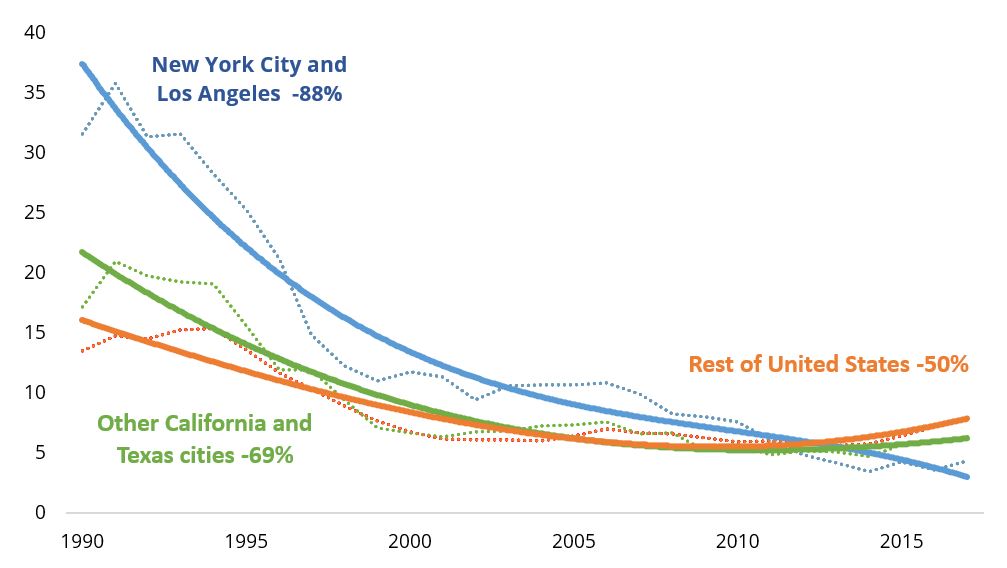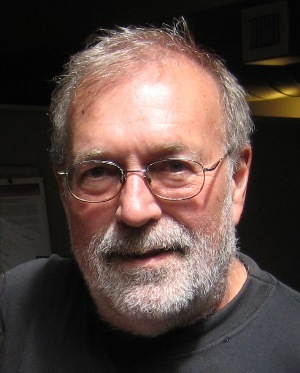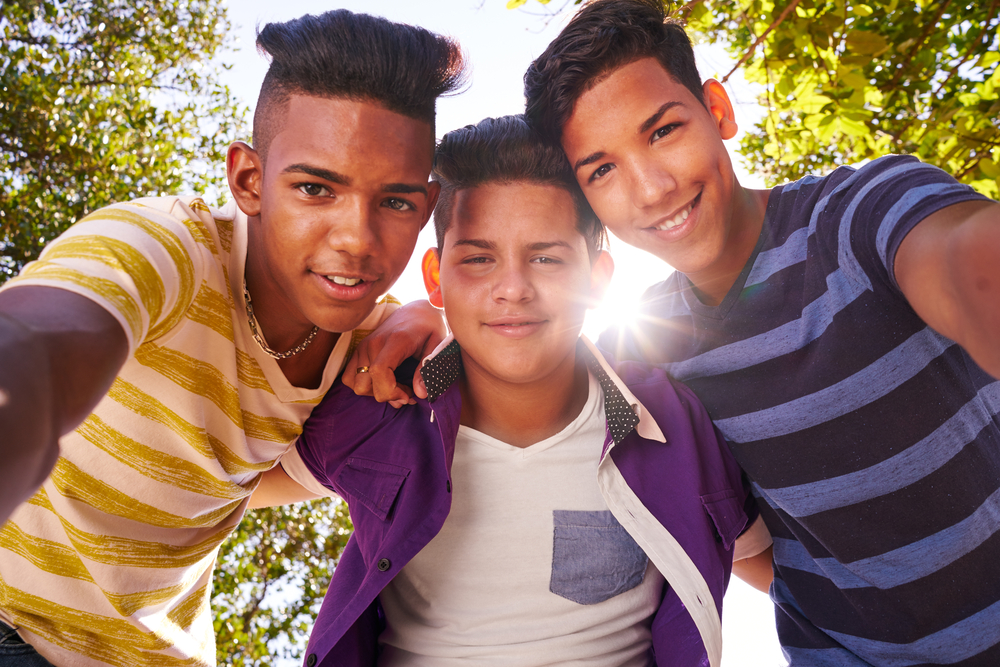![]() Leaders across the United States agonize over recent mass shootings as Americans fear more to come. Perhaps we can learn from youth in two mega-cities where gun violence has fallen dramatically even as politicians fail to act.
Leaders across the United States agonize over recent mass shootings as Americans fear more to come. Perhaps we can learn from youth in two mega-cities where gun violence has fallen dramatically even as politicians fail to act.
Teenagers in the nation’s two largest metropolises, New York City and Los Angeles, once suffered gun killing rates triple the national average. Over the last 25 to 30 years, however, teens’ gun death rates in these two cities have fallen by an astonishing 88%, including drops of 88% in gun homicides and 81% in gun suicides.

Centers for Disease Control
Trendlines are polynomial functions incorporating all data points.
In the LA-Compton-Long Beach areas, homicide arrests of youths fell from 289 in 1990 to 15 in 2018, mirroring a trend in youth crime declines across urban California. Comparing 2018 to their respective peak arrest years of the early 1990s, youths’ homicide arrests fell from 34 to one in San Francisco, 25 to one in Oakland, 24 to two in Sacramento, and 16 to one in Fresno. As the teenaged youth population in the state’s 15 largest cities rose by 200,000 to over 1.1 million, murder arrests of youths fell from 373 in 1990 to 36 in 2018.
What caused such spectacular declines in gun deaths? Anti-violence programs? Many cities have implemented these; Chicago, Philadelphia, Boston and Minneapolis are noteworthy. Yet none show gun violence reductions approaching those of LA and NYC. Gun control laws, perhaps? California and New York boast the nation’s strictest and sixth-strongest gun control policies, respectively, including background checks and restrictions on high-capacity weaponry.

Mike Males
However, there are additional factors to consider. Other cities in states with strong gun control laws do not show declines in gun killings as large as LA and NYC. Further, large cities in Texas with “very weak” gun laws have also experienced larger than average gun-death declines. In Dallas-Fort Worth, teenagers’ rates of gun homicide fell by 80% and gun suicide by 63% over the last 25 years.
Further, as California’s young-age gun killings have decreased, those by the state’s white middle-aged adults are experiencing a troubling trend in the opposite direction. In California’s 25 inland, politically conservative counties, middle-aged white people ages 40 to 69 now are considerably more likely to be arrested for homicide and to die by gun homicide than teenagers living in the state’s major urban areas.
What accounts for these shifts as rural white middle-agers suffer higher gun homicide rates than teens in big cities overturn decades of crime theory?
One factor might be immigration. New York City and cities in California and Texas have had the nation’s largest influxes of immigrants. NYC and LA have four million more Latino and Asian residents than they did in 1990. Eight in 10 teens in these cities are youth of color; more than half have at least one immigrant parent.
The remarkable developments among diverse LA and NYC youth — as well as youth in other California and Texas cities — may signal the emergence of new multicultures dramatically diminishing urban violence and social problems, including crime, substance use, unplanned pregnancy and school dropouts.
We don’t understand these spectacular trends because we haven’t studied them — or even admitted they are happening. Why are progressive lobbies and those seeking pathways out of America’s gun-policy gridlock ignoring such encouraging developments?
The reasons may not be edifying. For one, interest groups and authorities have narrowed the gun debate simply to gun control versus gun rights. Both sides tend to maintain the image of teenagers as dangerous and endangered. Information, no matter how compelling, that does not advance established agendas (or, worse, challenges them) is unwelcome.
Second, the reality of racially diverse urban teens being safer from gun violence than middle-aged white individuals, as seen in California, is a sobering challenge to dominant adulthood. Ideology-driven experts, politicians, lobbies and media reporters prefer simplistic moralizings, such as pointing fingers at teenagers “destroyed” by smartphones, video games and immigrant gangs. We see ourselves as rescuers of wayward youth, not humbly learning from them.
If big-city youth are going to lead the way in confronting epidemic social crises such as gun violence, they could use our informed support.
Mike Males is senior research fellow for the Center on Juvenile and Criminal Justice in San Francisco. He is author of “Teenage Sex and Pregnancy: Modern Myths, Unsexy Realities.”

Great article. These stats beg for further study as Mr. Males points out. The downward trends of youth violence and especially in urban areas and among youth of color strongly suggest something positive is occurring and as Mr. Males states, it must be looked at closer to determine what we can learn from these youth. But our stereotypes of teens as dangerous and violent I believe keep us from looking at teens for solutions to gun violence and so as Mr. Males points out, we keep doing the same ole same ole and seek solutions through gun laws as if the law can save us every time. Thanks Mr. Males, you have inspired me to write in support of your idea. We need to turn this ship around and be more reflective about how to solve our societal problems by looking at our targeted populations and be honest about who they are and not what we want to imagine.
Interesting article. Thanks for all your research and getting this out.
Check the rates of child abuse reports in these cities for 15-20 years ago and see the correlation.
Pingback: Why Have Teen Gun Death Rates Dropped in NYC, L.A.? | Geoffrey Gardner
Pingback: Why Have Teen Gun Death Rates Dropped in NYC, L.A.? | The Crime Report